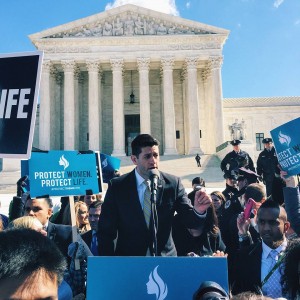‘Stop the Sham, Stop the Sham!’ abortion advocates yelled with aggression as I stood near the steps of the United States Supreme Court. I was there to emcee a rally called “Protect Them Both” on the day the Supreme Court heard arguments for Whole Womans Health vs. Hellerstedt.

Protect Them Both rally
Abortion activists claim Texas’s HB2 law requiring abortionists to have admitting privileges to hospitals within 30 miles of their clinic is an undue burden and a “sham.” Truth be told, it’s one of a few basic, common sense regulations that seek to protect women’s lives – one that all other types of surgical facilities have to follow.
As Americans United for Life states:
Admitting privileges requirements have been on the books for nearly 30 years and are currently in place in more than a dozen states. Consider this: Abortion providers routinely claim that 2.5 percent of women who have a first-trimester abortion “undergo minor complications,” while fewer than 0.3 percent experience a complication requiring hospitalization. Taking these conservative estimates at face value and using the latest abortion statistics from Guttmacher Institute (for 2011), that would mean, across the U.S., 26,500 women experienced complications and approximately 3180 women required post-abortion hospitalization in 2011.

Tonya Reaves
I talked to a nurse who works at an ER who told me how often women come in after their botched abortions. They come alone, without medical information from their abortionist. Admitting privileges would change that by holding abortionists accountable to their patients. Tonya Reaves died from a botched abortion after being transported to a Chicago hospital five hours after she first experienced bleeding. When she was finally transferred, the ER workers weren’t given information as to her injuries. The abortionist, Mindy Gittler, didn’t have proper licensing and had several complaints filled against her. While Tonya was bleeding to death, Gittler was working on her next patient.
Although the National Abortion Federation (NAF) would like to forget it, in 2000 they released a publication titled, “Having an Abortion? Your Guide to Good Care.” In that document they said women should look for abortion providers who “[i]n the case of an emergency,” can “admit patients to a nearby hospital (no more than 20 minutes away).” So what has happened in the sixteen years since the NAF’s advice that would make them now fight against such a common sense recommendation?

Jennifer Morbelli (bride), one of Carhart’s victims
Abortionists shouldn’t be allowed to give substandard care to women. Admitting privileges would improve continuity of care for their patients, ensure a minimum of physician competence, prevent doctor miscommunication and prevent them from abandoning their patients. When Jennifer Morbelli was having complications after her abortion, she couldn’t even reach her abortionist, LeRoy Carhart, a late-term abortionist with offices in more than one state. Carhart had already left the state, leaving Morbelli with only a phone number to call in case of an emergency – a phone number to his wife’s horse business. No other informational assistance was given to medical personnel. By the time Jennifer’s family reached Carhart, it was too late to save her life.
When we discuss Whole Women’s Health vs. Hellerstedt it’s important to know Texas’s HB2 law establishing safety regulations was a response to the horrors of infamous abortionist Kermit Gosnell’s trial. Gosnell is in prison for life after killing 44-year-old Karnamaya Mongar and 3 infants born alive after abortion. When Ms. Mongar died, it took paramedics more than 20 minutes to take her to the waiting ambulance because the abortion facility’s hallways were too cramped to accommodate a stretcher and the emergency exit lock had to be cut open.

When the Grand Jury for the case made their report, their fifth recommendation found on page 248 of the report stated, “The Pennsylvania Department of Health should license abortion clinics as ambulatory surgical facilities.”
The report says:
There is no justification for denying abortion patients the protections available to every other patient of an ambulatory surgical facility, and no reason to exempt abortion clinics from meeting these standards. The inspection of abortion facilities is too important a responsibility to be left to the discretion of the Department of Health, subject to the whim of bureaucrats and lawyers who have abdicated their duty to uphold the law. As ASFs, abortion providers would be subject to mandatory annual inspections. If a facility failed to meet the standards required for all ambulatory surgical facilities, it would lose its license.

Speaker of the House Paul Ryan fighting to protect them both
Some of HB2’s basic health standards include sanitary requirements, adequate staffing, and hallways that are wide enough for a first responder to move a stretcher through in case of an emergency. Abortion facilities have closed down in Texas because they refuse to meet these regulations. And the plaintiff in the Texas case, Whole Woman’s Health, has failed health inspections more than ten times in four years, for serious violations like failing to properly sterilize surgical instruments. Even if it’s costly to make changes, women’s lives are worth it.
The Supreme Court should uphold HB2 because commonsense regulations save women’s lives. It is the duty and the right of states to establish laws that will protect and care for their residents. If we want to #StopTheSham, lets expose abortionists who give substandard care to women for the sake of profit.








